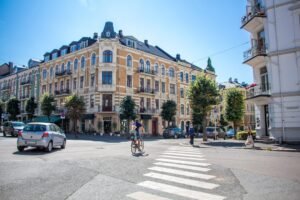

Norwegian Words for Technology and Internet: Staying Connected Using Norwegian
The Norwegian language plays a significant role in technology and internet communication in Norway. With a population of over 5 million people, Norway has a strong presence in the digital world, and being able to communicate effectively in Norwegian is essential for navigating the country’s online landscape. Whether you are planning to visit Norway or simply want to connect with Norwegians online, learning Norwegian technology and internet vocabulary is crucial.
Table of Contents
ToggleKey Takeaways
- Norwegian technology and internet vocabulary is essential for effective communication online.
- Common Norwegian words for online communication include “e-post” for email and “nettsted” for website.
- Norwegian terms for social media platforms include “Facebook” and “Instagram.”
- Understanding Norwegian internet slang and abbreviations is important for effective communication online.
- Norwegian words for cybersecurity and online safety include “passord” for password and “sikkerhet” for security.
Common Norwegian words for online communication
When it comes to online communication, there are several basic Norwegian phrases and words that can come in handy. For instance, “hei” is the Norwegian word for hello, “takk” means thank you, and “ha det bra” is used to say goodbye. These simple phrases can help you initiate and end conversations in a polite manner.
In addition to these basic phrases, it is also important to familiarize yourself with common Norwegian abbreviations used in online communication. For example, “lol” stands for laugh out loud, and “btw” is an abbreviation for by the way. Understanding these abbreviations can help you follow conversations and participate in online discussions more effectively.
Norwegian terms for social media platforms
Social media platforms are widely used in Norway, just like in many other countries. Some of the most popular social media platforms in Norway include Facebook, Instagram, and Snapchat. It is important to know the Norwegian terms for these platforms if you want to connect with Norwegians online.
For example, on Facebook, the term for “like” is “liker,” while “comment” is “kommentar.” On Instagram, “like” is “liker,” and “comment” is “kommentar.” Similarly, on Snapchat, “snap” is “snapp,” and “story” is “historie.” Knowing these terms will enable you to navigate these platforms more easily and engage with Norwegian users.
How to navigate Norwegian websites using technology vocabulary
Navigating Norwegian websites can be made easier by understanding common Norwegian words for website navigation. For instance, “hjem” means home, “om oss” is used for about us, and “kontakt oss” is the term for contact us. These words are often found in the navigation menu of websites and can help you find the information you are looking for.
In addition to website navigation, it is also important to understand Norwegian website design and layout. Norwegian websites often have a clean and minimalist design, with a focus on functionality and user experience. Familiarizing yourself with the layout of Norwegian websites can make it easier for you to find what you are looking for and navigate the site more efficiently.
Norwegian words for mobile devices and apps
Mobile devices and apps are an integral part of everyday life in Norway, just like in many other countries. Knowing common Norwegian words for mobile devices can be helpful when communicating about technology. For example, “mobiltelefon” is the Norwegian word for mobile phone, while “nettbrett” is used for tablet.
Similarly, understanding the Norwegian terms for popular apps can also be useful. For instance, “WhatsApp” is pronounced the same way in Norwegian, while “Tinder” is also used in Norway. Knowing these terms can help you communicate about mobile devices and apps more effectively.
Understanding Norwegian internet slang and abbreviations

Just like any other language, Norwegian has its own internet slang and abbreviations that are commonly used in online communication. Some common examples of Norwegian internet slang include “fml” (fuck my life) and “btw” (by the way). Understanding these slang terms can help you follow conversations and participate in online discussions more effectively.
In addition to internet slang, there are also several abbreviations that are commonly used in online communication in Norway. For example, “lol” stands for laugh out loud, and “omg” is an abbreviation for oh my god. Familiarizing yourself with these abbreviations can make it easier for you to understand and participate in online conversations.
Norwegian words for cybersecurity and online safety
Cybersecurity and online safety are important considerations when using the internet, regardless of the country you are in. In Norway, it is important to know common Norwegian words for cybersecurity and online safety. For example, “sikkerhet” means security, while “passord” is the Norwegian word for password.
Understanding Norwegian online safety practices is also crucial. This includes using strong passwords, avoiding suspicious links, and being cautious when sharing personal information online. By familiarizing yourself with these practices and the corresponding Norwegian vocabulary, you can protect yourself while using the internet in Norway.
How to use Norwegian search engines and online directories
When searching for information online in Norway, it is important to know how to use Norwegian search engines and online directories. Some popular Norwegian search engines include “Google” and “Kvasir.” These search engines can help you find relevant information in Norwegian.
In addition to search engines, there are also online directories that can be useful when looking for specific businesses or services in Norway. One example is “Gule Sider,” which is the Norwegian equivalent of Yellow Pages. Understanding how to use these search engines and directories can make it easier for you to find the information you need while in Norway.
Norwegian vocabulary for e-commerce and online shopping
E-commerce and online shopping have become increasingly popular in Norway, especially in recent years. Knowing common Norwegian words for e-commerce can be helpful when navigating online stores. For example, “nettbutikk” is the Norwegian term for online store, while “betaling” means payment.
Understanding Norwegian online shopping practices is also important. This includes comparing prices, reading reviews, and being aware of return policies. By familiarizing yourself with these practices and the corresponding Norwegian vocabulary, you can make informed decisions while shopping online in Norway.
Staying connected in Norway: Using technology and internet in everyday life
Technology and the internet play a significant role in everyday life in Norway. From communication to entertainment, Norwegians rely on technology and the internet for various purposes. Whether you are a visitor or a resident, staying connected in Norway is essential.
One tip for staying connected in Norway is to take advantage of public Wi-Fi. Many public places, such as cafes, restaurants, and libraries, offer free Wi-Fi access. This can be a convenient way to stay connected without using up your mobile data.
Another tip is to download useful apps that can enhance your experience in Norway. For example, there are apps for public transportation, weather forecasts, and language translation. These apps can make it easier for you to navigate the country and communicate with locals.
In conclusion, learning Norwegian technology and internet vocabulary is important for effective communication and navigation purposes in Norway. Whether you are planning to visit the country or simply want to connect with Norwegians online, understanding the language of technology and the internet can greatly enhance your experience. By familiarizing yourself with common Norwegian words and phrases related to online communication, social media platforms, website navigation, mobile devices and apps, internet slang and abbreviations, cybersecurity and online safety, search engines and online directories, e-commerce and online shopping, as well as staying connected in everyday life, you can navigate the digital landscape of Norway with ease.
If you want to learn Norwegian, you can register for classes here. We look forward to hearing from you and helping you become fluent in Norwegian.





